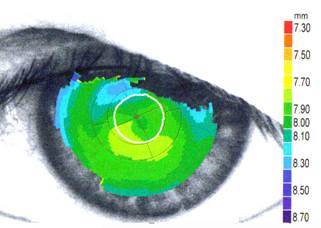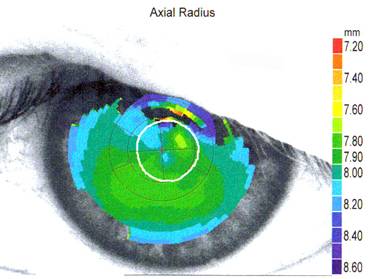An irregular cornea can best be masked by an RGP lens. Unfortunately not all patients can tolerate RGP lenses. This is specially the case if the irregularity affects only one eye. In cases like this patients often have problems adapting because of the constant feedback from the other eye. It’s been reported in the literature that using thick hydrogel lenses can also help in cases of low grade irregularities, but to be successful they have to be made thicker than conventional hydrogel lenses. This often leads to a lens thickness that can not fulfill the minimum oxygen requirement for safe daily wear.
Case report
A 65 year old male presented to us 4 months after having cataract surgery in the left eye. He had the same procedure in the right eye one year before. Both surgeries went well and no complications were reported. The patient was referred to us by the ophthalmic surgeon with the goal of correcting his irregular left cornea with an RGP lens. The nature of the irregular cornea after cataract surgery was obscure and could not be explained.
Subjective assessment
The patient confirmed that he never had any problems with his eyes and saw well with both of them until about two years ago when the cataract started to develop. He was perfectly happy with his right eye. The vision with his left eye did not bother him because according to him he saw well enough with his right eye. Besides that, he wasn’t too keen on wearing a contact lens.
Objective assessment
| Refraction |
OD plano -0.75 cyl 103° |
Va 20/20 |
| |
OS plano |
Va 20/60 |
| |
| K readings |
OD 7.80 / 7.80 regular mires |
|
| |
OS 7.80 / 7.78 irregular mires |
|
| |
| Corneal Topography |
| |
OD regular corneal pattern |
|
| |
OS irregular pattern with a central island |
|
| |
| Slitlamp biomicroscopy of anterior segment |
| |
OD within normal limits |
|
| |
OS faint haze visible at the anterior part of the stroma - centrally located, everything else within normal limits |
| |
| Ophthalmoscopy |
| |
OU within normal limits |
|
Trial fitting:
| Rigid gas permeable lens |
| |
OS 7.85 –1.00dpt |
9.8 mm |
over refraction plano |
Va 20/ 30 |
| |
| Silicone hydrogel lens |
| |
OS 8.6 –0.75dpt |
13. 8 mm |
over refraction +0.75dpt |
Va 20/50 |
| |
OS 8.6 +2.50dpt |
13.8 mm |
|
Va 20/30 at near |
| |
|
|
over refraction -2.50dpt |
Va 20/40 at distance. |
 |
| Figure 1: Corneal topography of left eye 4 months after cataract extraction |
Assessment
OS irregular cornea with a faint corneal haze of obscure nature. By using an RGP lens the left eye cannot be corrected to 20/20. The patient is not really motivated to wear a contact lens because of perceptions of discomfort and difficulties with handling.
Plan To smooth the corneal surface we decided to fit the patient with a silicone hydrogel lens which would give him the desired comfort; the rigidity of the lens material would help to mask the irregularity. We decided to use a plus power to get a slightly stiffer lens which would also help with handling. We speculated that the plus power would benefit the patient for near when he was not wearing his glasses and therefore would help to keep him motivated to wear the lens.
We explained to the patient our plan of using a 8.6 +2.50 dpt 13.8 mm silicone hydrogel lens on his left eye and the importance of using the lens in a daily wear modality during the first week.
Follow up after one week: The patient adapted well to the monovision fit, he was happy with the lens because it gave him the option of going through his daily mail without glasses for most of the time. Since the cornea did not show any staining or any increase in limbal hyperaemia we decided to switch to continuous wear for the next two weeks.
Follow up after two weeks continuous wear: The patient was still happy with the lens and had no problems.
Objective findings
| Contact lens evaluation |
| |
OD no lens |
|
|
| |
OS over refraction |
-2.50 sph |
Va 20/20 |
| |
| Refraction |
| |
OD plano |
-0.75 cyl 103° |
Va 20/20 |
| |
OS -0.25sph |
-0.50 cyl 165° |
Va 20/25 |
| |
| Slitlamp biomicroscopy of anterior segment |
| |
OU no change to the pre fitting evaluation |
|
|
Assessment
The lens was well tolerated in the continuous wear mode and helped to reshape the corneal surface
Plan Due to the positive development of the cornea and the resulting visual acuity it was decided to stay in continuous wear mode for a month
Follow up after 1 month continuous wear: The follow up visit after 1 month continuous wear showed the same finding as the one week follow up, except that the findings were more pronounced. Objective findings
| Contact lens evaluation |
| |
OD no lens |
|
|
| |
OS over refraction |
-2.00 sph |
Va 20/20 |
| |
|
|
|
| Refraction |
| |
OD plano |
-0.75 cyl 103° |
Va 20/20 |
| |
OS +0.50sph |
-0.75 cyl 135° |
Va 20/20 |
| |
|
|
|
| Slitlamp biomicroscopy of anterior segment |
| |
OU no change to the pre fitting evaluation |
 |
| Figure 2: Corneal topography after 1 month continuous wear of a silicone hydrogel lens |
Assessment
The lens was well tolerated in the continuous wear mode and helped to reshape the corneal surface to a regular surface Plan
Since the patient was happy with his monovision and the lens was well tolerated, we decided to stay in the continuous wear mode with a monthly replacement schedule. The next follow up visit was scheduled for 6 months
During a one month vacation he decided not to wear his lens because he often went swimming. After the vacation his cornea became slightly irregular again, but he could still be corrected to 20/20 - by refraction.
 |
| Figure 3: Corneal topography after 1 month cessation of lens wear due to vacation |
Summary Practitioners often have a tendency to be bound by optometric convention. This case illustrates the advantages to be gained from considering all available options when fitting patients and also highlights the importance of taking all factors such as lens Dk, rigidity, and lens comfort into consideration when fitting an irregular cornea. |